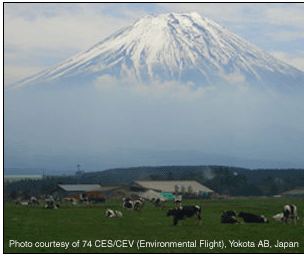



What Protects Japan’s Dairy Industry?
By John Dyck and published by Amber Waves, Economic Research Service, USDA - Prices for milk and dairy products in Japan at all levels, from farm to retail, are much higher than U.S. prices. Retail prices of fluid milk in Japan, for example, are more than double U.S. prices, and butter prices are almost twice as high as U.S. prices. Japan’s high prices persist because of geographic factors and government policies. Japanese dairy farms are smaller in area than U.S. dairy farms, and milk producers in Japan must import grain and fodder from distant sources. These factors translate to high costs for Japanese producers. Japan’s location also makes it difficult to ship fresh, fluid milk to Japan from lower cost suppliers in Australia, New Zealand, or the Western Hemisphere. Thus, over 40 percent of Japan’s dairy product consumption depends on local production.
Japanese dairy farms are smaller in area than U.S. dairy farms, and milk producers in Japan must import grain and fodder from distant sources. These factors translate to high costs for Japanese producers. Japan’s location also makes it difficult to ship fresh, fluid milk to Japan from lower cost suppliers in Australia, New Zealand, or the Western Hemisphere. Thus, over 40 percent of Japan’s dairy product consumption depends on local production. Manufacturing milk, used to produce butter, skim milk powder, and cheese, can be replaced cost effectively by imports of the final products. The cheese market illustrates the potential importance of Japan in global dairy trade. Japan is the second-largest cheese importer in the world, behind only the United States. Japan’s tariffs on cheese range from 22 to 40 percent, and Japan does not use tariff-rate quotas (TRQs) to limit cheese imports.

For dairy products other than cheese, Japan’s government uses TRQs to support the production of manufacturing milk. Tariffs on imports outside the quotas are so high that they effectively eliminate trade. In addition, the government provides a direct subsidy for each liter of manufacturing milk produced within Japan’s production quota. Together, the higher prices supported by the TRQs and subsidy payments provide about $1.8 billion in support to manufacturing milk production.
If Japan were to eliminate its TRQs and subsidies, Japanese consumers would benefit from lower prices for dairy products. Much of Japan’s manufacturing milk production would be replaced by imports of butter and milk powder, providing new markets for producers of manufacturing milk in lower cost regions of the world. Even if that were to happen, however, Japan’s large consumption of fresh, fluid milk would continue to support a large dairy industry in Japan.
September 2006


